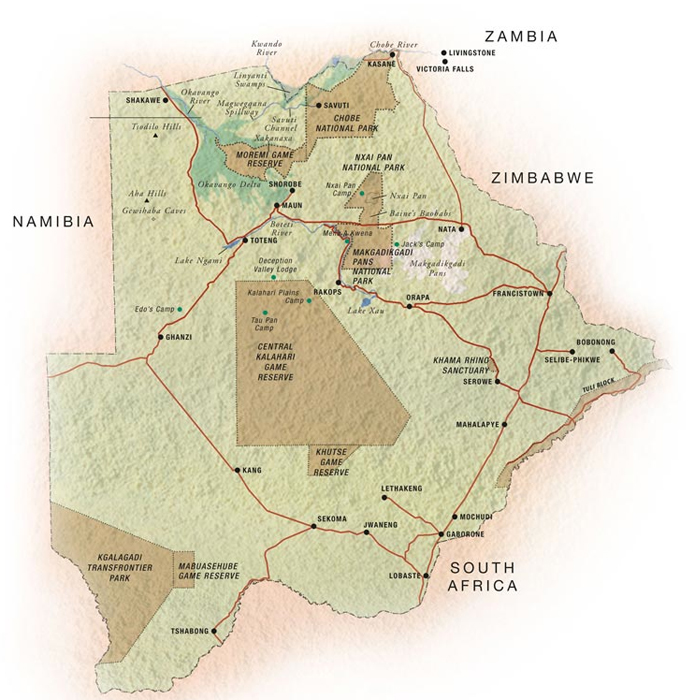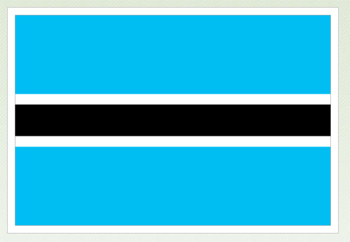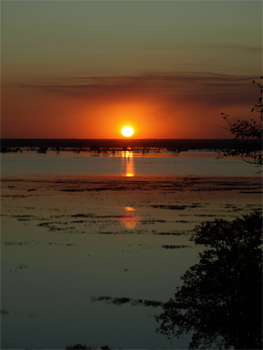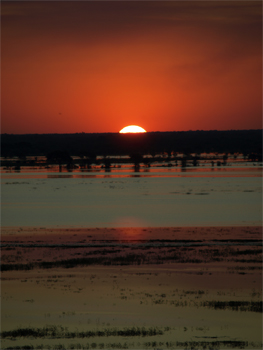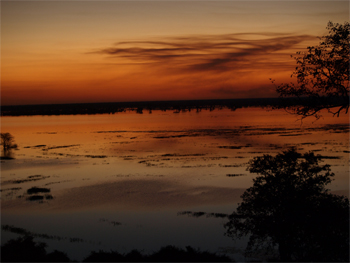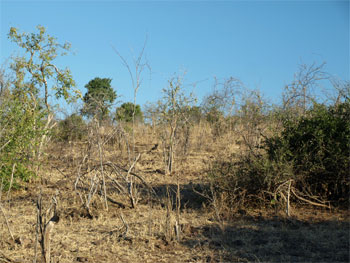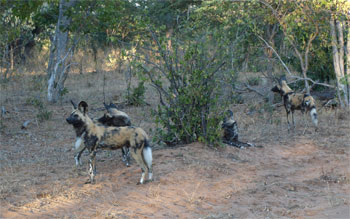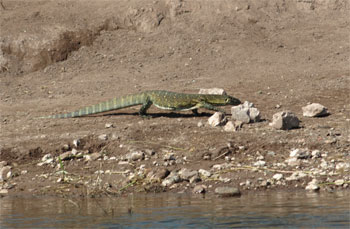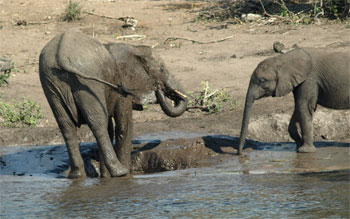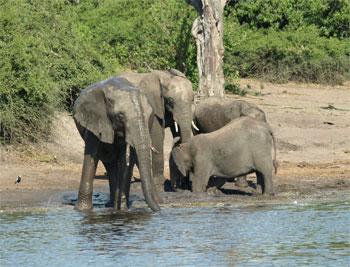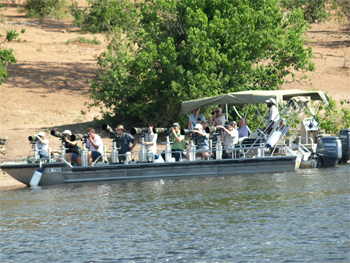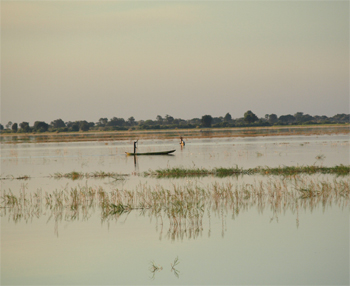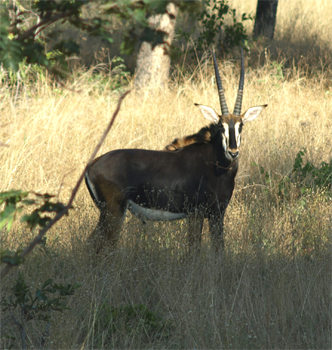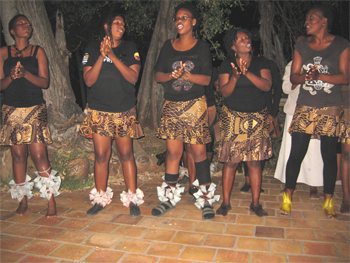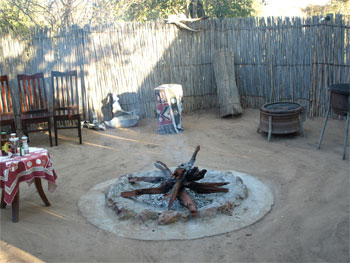May 13 to 16 - Baobab Safari Lodge, Chobe National Park, Botswana
We ate a very nice buffet breakfast at the hotel and at 8:30 we joined the 10 incoming travellers and learned names while waiting for our escort to take us to the airport. Our flight on British Airlines left at 11:50 and landed in Victoria Falls at 1:30 where we met our OAT tour guide for the main Ultimate Africa tour. We had to pass through immigration and then board another bus to drive two hours to the Botswana border, get off and walk through a disinfectant against hoof and mouth disease, and pass through Botswana immigration. We got on a third bus with Botswana registration for the two-hour drive to the Baobab Safari Lodge just outside Chobe NP. We arrived at 5:30.
Map of Botswana showing the location of Chobe NP (top, coenter) and the Okavango Delta and Moremi Game Reserve area where we will go after Chobe
|
|
Flag of Botswana
|
Typical license plate |
The Baobab Safari Lodge is nice and has a great view of the Chobe River and surrounding savannah. We watched a gorgeous sunset while learning about our new home. It is nowhere near as plush as Pafuri but will make us feel more like we are living in the African outdoors. There are loads of elephant families wandering around our camp along with impalas and baboons.
Chobe River from the Baobab Safari Lodge |
|
|
|
Savanah, forest, Chobe River in the distance |
 |
The Chobe game drives were very different from the ones in Kruger. The terrain is all Kalahari Desert adjacent to the Zambezi River. When it rains (Oct. to Apr.) the river floods and so is very high right now. The rain simply disappears into the sand. The sand packs down and the roads are not muddy but hard packed. Now we are entering the dry winter and the roads are rutted sand. Vegetation grows in this soil so it has grass, shrubs, and trees. This park has more elephants than anywhere else in Africa and they eat the trees and shrubs and knock them down as they move around. Some areas are almost totally destroyed, but the rains will allow them to recover. We also saw a dozen or more giraffes that were happily denuding the taller trees.
Elephant damage
|
Lots of Giraffes |
We saw different animals ,including: red Lechwe, who are water antelope with shorter front legs than rear ones; a hyena, with its sloping back; steenbok, a very small antelope; Sable antelope with white markings on its face and long black hide; black-backed jackal; and two water monitor lizards who looked like small alligators. The birds we added to the list included: blacksmith or lapwing plover, tawny eagle, brown snake eagle, and red-billed ox pecker on the buffalos. Link to the Animals and Birds pages to see pictures (use the Back arrow to return here).
| We had a native basket weaving demonstration bythree local women. They use marsh grass and palm leaves. The palm leaves are boiled for three hours to make them white and then soaked in various concoctions found in the bush to dye them - aloe, rusty tin can, bird plum fruit, rot of something, etc. The three women had their baskets on display and for sale. They were very neatly made and attractive and reasonably priced. | 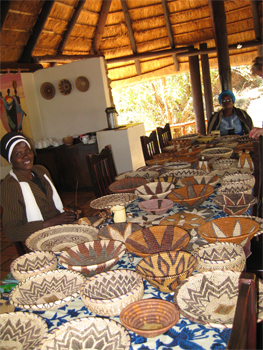 |
The second morning we went off for a boat ride on the Chobe River. On our way out to the town of Kasane, on the east side of Chobe NP, we saw another pack of wild dogs. They sort of look like German shepherds, with brown, black, and light patches of fur, and white at the ends of their tails. We also stopped to see a python about six feet long. They are not poisonous, but coil around their prey and squeeze it to death. A full-grown python can kill and swallow an impala (the horns hang out of its mouth). It will take the python about three months to digest the impala during which time they can't move and are vulnerable to other predators.
In Kasane we got on a 16-passenger pontoon boat and sat in director chairs. At least it had a canvas roof to give us shade. We went up the Chobe River along the Botswana shore and came back through the flooded grasslands in the larger channel. Namibia was on the far shore.
On this boat trip we saw several new species of birds: double banded sand grouse, African hawk eagle, hammer head hawk, Kori bustard, blue starlings, pied kingfisher, Malibu stork, yellow-billed stork, whistling duck, and crowned hornbill. They are pretty and different but we like watching the activities of the animals - the birds just sit there!
We saw a mob of mongooses that would like to eat the crocodile eggs, as would the monitor lizards.
|
|
Our favorites on the boat ride were the elephants drinking, spraying water, and digging mud to throw on their backs. One young one got down on his knees to wallow. The mud removes parasites from their skin.
|
|
|
|
We saw lots of hippos. They are huge and not very active. They lie (or stand) together in the shallow water to keep cool. Some walk into deeper water and submerge for up to seven minutes then rise and blow out air and take another breath. They are the dangerous ones because you don't know where they are going or where they will rise. We saw several young ones who were not quite as content to sit still. They still don't move much. The ones on land look like huge water tanks. They lie on their sides with their pink bellies showing or stand with their chins resting on the ground. They did not cooperate by yawning and showing their huge mouths for the camera!
|
|
We weren't the only ones on the river although we didn't have camera equipment like this.
|
|
Native river boat - Mokoro
|
|
We also saw a group of the rare sable antelope. The female is brown and the male is an impressive black with white markings on his face.
|
|
Before dinner at camp tonight the staff entertained us with several of their native songs. They set the rhythm with their feet and sing in wonderful harmony. The tribal songs were requests that would ask the tribal chief to do something for them.
We then went to their boma (outside eating and meeting area) for a traditional tribal meal. Usually the meal would just be a main course, but we started with a thick lentil soup that we had to eat the traditional way - with a piece of bread and our fingers. We sat in straight chairs and had to balance our tin plates on our knees. They then let us use utensils for grilled beef, polenta (white corn mush), wonderful spinach with onion and garlic, butternut squash and salad. For dessert we had "orange snow." The frozen orange and cream was served in a frozen orange half. It was all very tasty. We chatted with our "tribal chief" about how things were handled in local tribes.
Native costumes |
The Boma |
Continue on next page
| Return to Top | Return to Itinerary | Return to Dreamcatcher Home Page |
